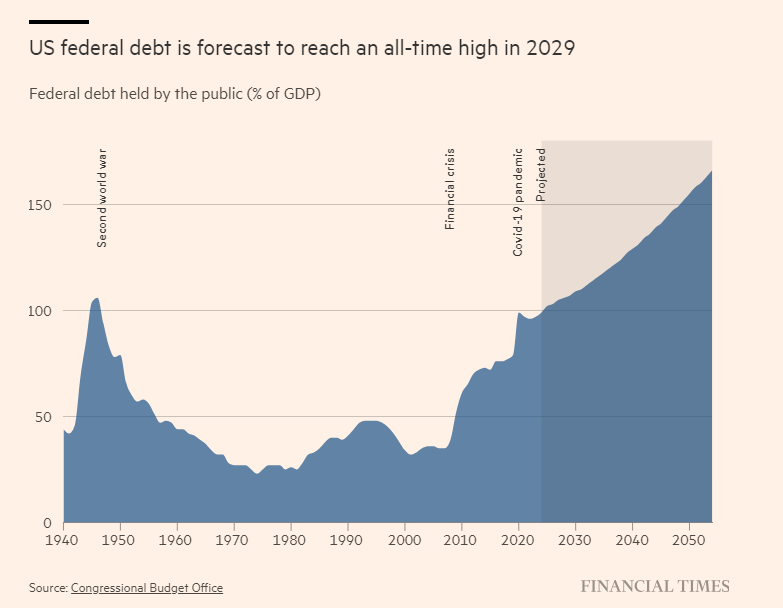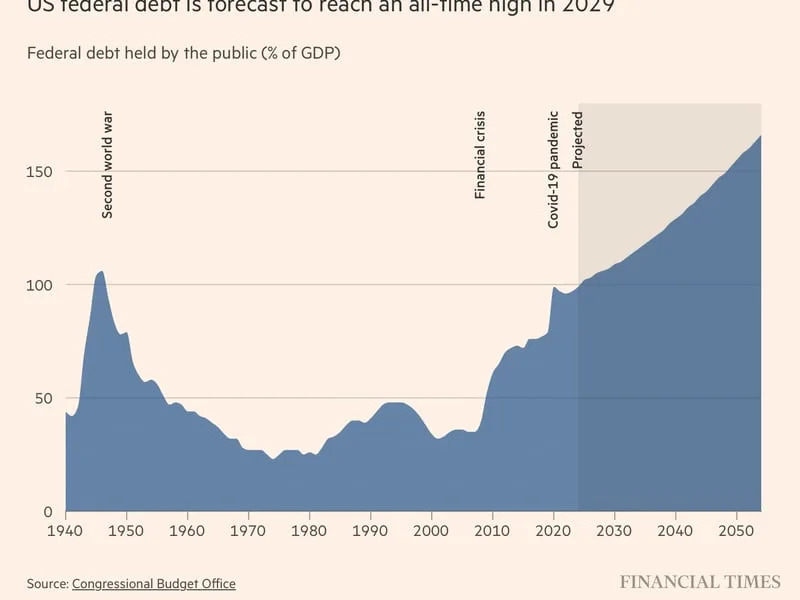風蕭蕭_Frank
以文會友債務“雪球”越滾越大!特拉斯式危機恐在美國上演?
美國國會預算辦公室(CBO)主任菲利普·斯瓦格爾(Phillip Swagel)周二警告稱,如果政府忽視美國不斷膨脹的聯邦債務,美國將麵臨利茲·特拉斯(Liz Truss)式的市場衝擊。
斯瓦格爾表示,美國的財政負擔正在以“前所未有”的速度增加,有可能引發類似於2022年導致英鎊擠兌和英國特拉斯政府垮台的危機。
2022年9月,英國前首相特拉斯推出了震驚世界的“迷你預算”。在英國通脹飆升,政府債務不斷增加的背景下,這份以“無資金減稅”為核心的預算一經曝光,就立即引發了英國金融市場的混亂,也拉開了英國抵押貸款利率不斷上漲的序幕。
斯瓦格爾表示,美國“尚未走到那個地步”,但隨著更高的利率導致其在2026年償還債務的成本上升至1萬億美元,債券市場可能會“迅速反彈”。
據CBO稱,截至去年底,美國聯邦債務總額達26.2萬億美元,占國內生產總值(GDP)的97%。
2017年美國前總統特朗普實施全麵減稅措施,並在疫情期間推出巨額刺激計劃後,美國債務規模激增。特朗普承諾,如果他在今年的總統大選中擊敗拜登,他將延長原定於明年到期的減稅措施。
斯瓦格爾表示:“一些看似溫和的變化——或者可能一開始是溫和的,然後變得更加嚴重——可能對利率產生巨大影響,從而對財政軌跡產生影響。”
斯瓦格爾向英國《金融時報》發表上述言論的前一天,該獨立監管機構發布了新的長期經濟預測。預測顯示,到2054年,美國債務水平將升至GDP的166%。
惠譽去年將美國的信用評級從“AAA”下調至“AA+”,理由是擔心“政府債務負擔過重且不斷增加”。穆迪仍將評級定為AAA,但去年11月表示,已將評級展望從“穩定”下調至“負麵”。
在斯瓦格爾就美國的債務負擔發出警告之際,經濟學家們擔心民主黨和共和黨多年來的財政揮霍行為將給美國經濟帶來麻煩。
彼得森國際智庫高級研究員金伯利·克勞辛(Kimberly Clausing)表示:“政策製定者有必要大幅削減赤字,部分原因是我們麵臨巨大的人口壓力。”
安盛投資管理公司宏觀經濟研究主管戴維·佩奇(David Page)表示:“兩位總統候選人都沒有談論財政廉潔,其中一位甚至還在談論延長減稅政策。”
美國盡責聯邦預算委員會(CRFB)的一家智庫表示,如果特朗普延長減稅政策,2026年至2035年間聯邦債務將增加5萬億美元。

特朗普延長減稅政策將導致2026年至2035年間的聯邦債務增加5萬億美元
CBO的預測顯示,未來10年,美國年度財政赤字占GDP比重將徘徊在約6%的水平——這是基於特朗普減稅政策計劃於2025年到期的假設。
斯瓦格爾曾擔任布什政府時期的美國財政部長。他承認,考慮到有關延長減稅和奧巴馬醫療保險額外補貼即將在明年到期,明年“對財政政策尤其重要”。
本周發布的CBO預測顯示,2029年債務占GDP的比率將超過二戰時期的最高水平,即116%,斯瓦格爾將這一趨勢描述為“前所未有的”。

美債占GDP比例將在2029年超越二戰水平
斯瓦格爾說:“二戰期間欠下的債務大部分在參戰的那一代人的時間內就還清了。如今產生的財政負擔不是我們這一代人所能承受的。”
他警告稱,隨著債務利息支付的增加,美元作為世界儲備貨幣的地位並不總是能夠使美國免受市場壓力。
“我們需要向外國人借款,因為外國資本有助於保持美國的低利率,”斯瓦格爾說,“但這也有兩麵性,一方麵,現金流向海外意味著國民收入損失。另一方麵,如果沒有資本流入供我們借款,那就更糟糕了。”
Soaring U.S. Debt Has Potential to Replay U.K.'s 2022 Market Shock, CBO Warns
https://ca.finance.yahoo.com/news/soaring-u-debt-potential-replay-121220987.html
Omkar Godbole ·3 min read
-
Unattended mounting U.S. debt concerns means potential for a Liz-Truss style market chaos, Phillip Swagel, director of the Congressional Budget Office told Financial Times.
-
Debt concerns may have helped bitcoin and gold rally to record highs amid elevated interest rates worldwide, analysts said.
In 2022, former U.K. Prime Minister Liz Truss announced radical economic measures, including deep tax cuts and billions of pounds of spending even as surging government debt called for fiscal prudence. The result was market chaos, with the British pound (GBP) crashing to record lows against the U.S. dollar (USD) and the collapse of Truss' government, the shortest in the country's history.
Now, the U.S. faces a similar risk if the government continues to ignore mounting debt concerns, according to Phillip Swagel, director of the Congressional Budget Office (CBO).
“The danger, of course, is what the U.K. faced with former Prime Minister Truss, where policymakers tried to take an action, and then there’s a market reaction to that action,” Swagel said in an interview with the Financial Times.
Swagel added that the U.S. is not yet in the same position, but higher interest rates could raise the debt servicing cost to $1 trillion in two years, and bond markets could "snap back."
A pound-like crash in the U.S. dollar, a global reserve currency with an outsized role in international finance, could boost demand for alternative assets with a haven appeal like bitcoin and gold. Trading volumes in bitcoin-pound pairs spiked during the U.K. crisis in September 2022.
Both bitcoin and gold may already be pricing in a crisis scenario. Despite elevated interest rates and bond yields worldwide, the two so-called zero-yielding assets have rallied to new record highs above $70,000 and $2,000, respectively. Both have surpassed their previous peaks set in 2020-21, when interest rates in the U.S. and other parts of the world were pinned near or below zero.
"Rising debt levels and geopolitical turmoil may have contributed to offset the impact of higher yields on both assets," Paris-based crypto data provider Kaiko said in Monday's edition of its newsletter.

U.S. federal debt totaled $26.2 trillion at the end of 2023, about 97% of gross domestic product, according to the CBO. The non-partisan, independent agency expects the debt-to-GDP ratio to rise past the Second World War high of 116% by 2029 and reach as high as 166% by 2054.
The bigger the debt, the greater the pressure to keep real – or inflation-adjusted – interest rates and bond yields artificially low. Higher rates and higher debt levels push the government's interest expenses higher, aggravating debt concerns.
Negative real rates often lead investors to move money out of fixed-income investments and into high-risk, high-return assets like technology stocks, cryptocurrencies and havens like gold, as seen in 2020-21.
"In a highly indebted economy, negative real [inflation-adjusted] rates and financial repression are a necessary condition to keep the system running, and fiat currency debasement remains the escape valve," the founders of newsletter service LondonCryptoClub said in Monday's edition, explaining debt concerns as a macro tailwind for bitcoin and gold.
According to the founders, Federal Reserve Chairman Jerome Powell's recent decision to stick to forecasts of three rate cuts in the coming months despite continued labor-market strength and a renewed uptick in inflation shows the central bank is now "focused on the U.S. debt spiral."
"Gold continues to signal that the macro sands are shifting. Should net ETF inflows turn positive this week, don’t be surprised if Bitcoin catches the macro winds and accelerates to new highs," the founders noted.
The Nasdaq-listed spot ETFs accumulated over $15 million in Monday, snapping a five-day streak of outflows. Bitcoin changed hands at $70,780 at press time, representing a 5% gain on a 24-hour basis, according to CoinDesk data. The CoinDesk 20 Index, a measure of the broader crypto market, added 5.5%.
UPDATE (March 26, 13:39 UTC): Rewrites headline




